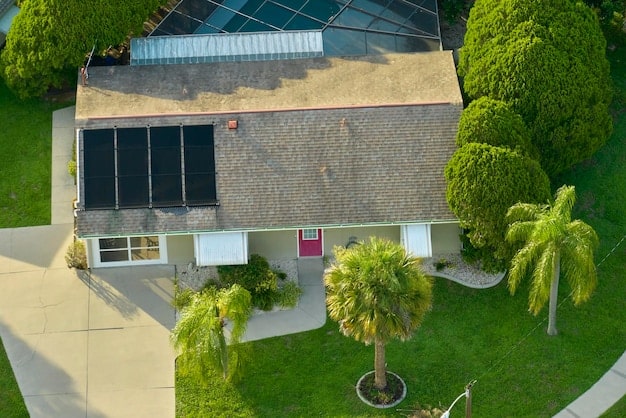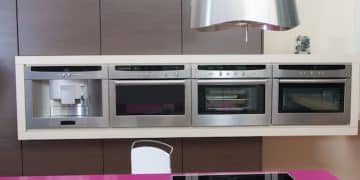US Government Incentives for Energy-Efficient Building Materials: Save Big!

US Government Incentives for Energy-Efficient Building Materials: Save Up to $5,000 are available through tax credits and rebates, encouraging homeowners and builders to invest in energy-efficient materials that reduce energy consumption and lower utility bills, promoting environmental sustainability and economic savings.
Are you looking to build or renovate your home with energy-efficient materials? The **US Government Incentives for Energy-Efficient Building Materials: Save Up to $5,000** can help you reduce your project costs while contributing to a greener environment.
Understanding US Government Incentives for Energy-Efficient Building Materials
The US government is committed to promoting energy efficiency and reducing carbon emissions. One of the ways they achieve this is through various incentives designed to encourage homeowners and builders to use energy-efficient building materials. These incentives can significantly lower the upfront costs of green building projects, making them more accessible to a wider range of people.
These incentives not only benefit individual homeowners but also contribute to broader environmental goals. By reducing energy consumption, we can lower our carbon footprint and create a more sustainable future for generations to come. Let’s delve into the details of these incentives and how you can take advantage of them.
Tax Credits for Energy Efficiency
One of the primary incentives is tax credits. These credits allow you to deduct a certain percentage of the cost of energy-efficient materials from your federal income taxes.
Rebates on Energy-Efficient Appliances
Rebates are another form of incentive, often offered at the state or local level. These rebates provide a direct discount on the purchase price of qualifying energy-efficient appliances and materials.

- Tax Credits: Offered at the federal level, reducing your tax burden by a percentage of your investment.
- Rebates: Provided by state and local governments, offering immediate discounts on purchases.
- Grants: Less common but can provide significant financial assistance for specific projects.
- Loan Programs: Low-interest loans designed to finance energy-efficient upgrades.
Understanding the various types of incentives available is the first step in making informed decisions about your building or renovation project. Each type has its own eligibility requirements and application process, so it’s essential to do your research and determine which options are the best fit for your needs.
Eligible Energy-Efficient Building Materials: What Qualifies?
When considering US Government Incentives for Energy-Efficient Building Materials: Save Up to $5,000, it’s essential to know which materials qualify. The government provides incentives for a range of products that meet specific energy efficiency standards. Knowing these materials can help you make informed decisions during your building or renovation project.
The list of eligible materials is comprehensive, covering various aspects of building construction and renovation. These incentives aim to promote materials that significantly reduce energy consumption and improve the overall energy performance of buildings.
Energy-Efficient Windows and Doors
Windows and doors are significant sources of energy loss in many homes. Upgrading to energy-efficient models can make a substantial difference.
Insulation Materials
Proper insulation is crucial for maintaining a consistent temperature inside your home, reducing the need for excessive heating and cooling.
- ENERGY STAR Certified Windows: These windows meet strict energy efficiency guidelines set by the EPA.
- High-Efficiency Insulation: Materials with a high R-value, indicating better insulation performance.
- Energy-Efficient Doors: Doors that minimize air leakage and heat transfer.
- Cool Roofing Materials: Roofing that reflects sunlight, reducing heat absorption.
Choosing the right energy-efficient materials can not only help you qualify for government incentives but also significantly reduce your energy bills over time. It’s a win-win situation for both your wallet and the environment. Carefully evaluate your options and select products that meet the required standards.
How to Apply for Government Incentives: A Step-by-Step Guide
Applying for US Government Incentives for Energy-Efficient Building Materials: Save Up to $5,000 might seem daunting, but with a clear understanding of the process, it can be straightforward. The application process typically involves several steps, from gathering the necessary documentation to submitting your claim.
Ensuring compliance with the requirements is crucial for a successful application. Missteps in the application process could lead to delays or even rejection of your claim. We’ll guide you through each step, providing helpful tips along the way.
Research Available Incentives
Begin by researching the specific incentives you are eligible for. Federal, state, and local governments may offer different programs with varying requirements.
Gather Required Documentation
Collect all the necessary documentation, such as receipts, product specifications, and installation records. This documentation is essential to prove that you meet the eligibility criteria.

- Identify Eligible Programs: Use online resources and government websites to find applicable incentives.
- Prepare Documentation: Keep detailed records of all purchases and installations.
- Submit Your Application: Follow the specific guidelines provided by each program.
- Follow Up: Stay informed about the status of your application and respond promptly to any requests for additional information.
By following these steps carefully, you can increase your chances of successfully applying for and receiving government incentives for energy-efficient building materials. Diligence and attention to detail are key to navigating this process effectively.
Maximizing Your Savings: Tips and Strategies
To truly maximize your savings with US Government Incentives for Energy-Efficient Building Materials: Save Up to $5,000, it’s crucial to employ strategic planning and informed decision-making. Simply choosing eligible materials isn’t enough; you need to understand how to optimize your approach to take full advantage of the available incentives.
Effective savings strategies involve careful budgeting, product selection, and project management. These strategies can help you not only reduce your initial project costs but also lower your long-term energy expenses. Let’s explore some key tips and approaches.
Combine Incentives
Explore the possibility of combining federal, state, and local incentives to maximize your savings. Some programs allow you to stack incentives, while others may have restrictions.
Plan Your Project Wisely
Plan your building or renovation project carefully, considering which energy-efficient upgrades will provide the greatest return on investment. Prioritize improvements that offer significant energy savings and qualify for multiple incentives.
When planning such projects, its important to analyze all aspects and avoid rushing things. This will not only allow you to save money but reduce risks as well.
- Conduct a Home Energy Audit: Identify areas where you can improve energy efficiency.
- Choose Energy-Efficient Materials Wisely: Select products that offer the best performance for your budget.
- Hire Qualified Contractors: Ensure proper installation to maximize energy savings.
- Stay Informed: Keep up-to-date with changes in incentive programs and eligibility requirements.
By following these tips and strategies, you can significantly increase your savings and make the most of government incentives for energy-efficient building materials. A well-planned and executed project will not only benefit your wallet but also contribute to a more sustainable future.
The Environmental Impact: Why Energy Efficiency Matters
Beyond the financial benefits of US Government Incentives for Energy-Efficient Building Materials: Save Up to $5,000, it’s important to consider the positive environmental impact. Investing in energy efficiency isn’t just about saving money; it’s about contributing to a healthier planet.
Energy-efficient building materials play a crucial role in reducing carbon emissions and conserving natural resources. By making conscious choices in our building and renovation projects, we can collectively make a significant difference in the fight against climate change.
Reducing Carbon Footprint
Energy-efficient materials help reduce the energy consumption of buildings, leading to lower carbon emissions from power plants.
Conserving Natural Resources
Using sustainable and recycled materials helps conserve natural resources and reduces the environmental impact of manufacturing processes.
- Lower Energy Consumption: Reduces the demand for fossil fuels and lowers greenhouse gas emissions.
- Sustainable Building Practices: Promotes the use of environmentally friendly materials and methods.
- Improved Indoor Air Quality: Energy-efficient materials often have low VOC emissions, improving indoor air quality.
- Reduced Waste: Encourages the use of recycled and recyclable materials, reducing landfill waste.
The environmental benefits of energy-efficient building materials are far-reaching and contribute to a more sustainable future. By choosing to invest in these materials, we are not only improving our homes but also making a positive impact on the world around us.
Future of Green Building: Innovations and Trends
The field of green building is constantly evolving, with new innovations and trends emerging regularly. As US Government Incentives for Energy-Efficient Building Materials: Save Up to $5,000 continue to drive adoption, understanding these advancements can help you stay ahead of the curve and make informed decisions about your building projects.
The future of green building is focused on creating structures that are not only energy-efficient but also sustainable, resilient, and healthy for occupants. From advanced materials to smart technologies, the possibilities are vast and exciting.
Smart Home Technologies
Integrating smart home technologies, such as smart thermostats and lighting systems, can further optimize energy efficiency and reduce consumption.
Advanced Building Materials
New materials, such as bio-based insulation and self-healing concrete, are being developed to improve the performance and sustainability of buildings.
- Net-Zero Energy Buildings: Buildings that produce as much energy as they consume, reducing reliance on the grid.
- Passive House Design: A rigorous standard for energy efficiency that minimizes heating and cooling needs.
- Green Roofs and Walls: Incorporating vegetation into building design to improve insulation and reduce stormwater runoff.
- Modular Construction: Off-site construction techniques that reduce waste and improve efficiency.
The future of green building is bright, with ongoing innovations and trends that promise to transform the way we design, construct, and live in our buildings. By staying informed and embracing these advancements, we can create a more sustainable and resilient built environment for future generations.
| Key Point | Brief Description |
|---|---|
| 💰 Save Up to $5,000 | Government incentives can significantly lower building costs. |
| ✅ Eligible Materials | Includes windows, doors, insulation, and roofing. |
| 🌍 Environmental Impact | Reduce carbon emissions and conserve resources. |
| 💡 Future Trends | Smart home tech and advanced building materials. |
Frequently Asked Questions
▼
The main types of incentives include federal tax credits, state rebates, and local grants. Tax credits reduce your federal income tax liability, while rebates offer discounts at the point of purchase. Grants provide direct financial assistance for specific projects.
▼
Common qualifying materials are ENERGY STAR certified windows and doors, high-efficiency insulation with a high R-value, and cool roofing materials. Other materials include energy-efficient HVAC systems and water heaters.
▼
To find local incentives, check your state and local government websites. You can also consult with local energy providers, contractors, and home improvement stores, who often have information about available programs.
▼
Some incentives have income restrictions to ensure they benefit those who need them most. Check the eligibility requirements for each specific program to see if income limits apply. Programs vary quite a bit.
▼
Typically, you will need receipts for your purchases, product specifications showing that the materials meet energy efficiency standards, and installation records. Keep all documents organized to expedite the application process.
Conclusion
Navigating the US Government Incentives for Energy-Efficient Building Materials: Save Up to $5,000 can unlock significant savings and contribute to a more sustainable future. By understanding the types of incentives available, identifying eligible materials, and following the application process, you can make informed decisions that benefit both your wallet and the environment.





